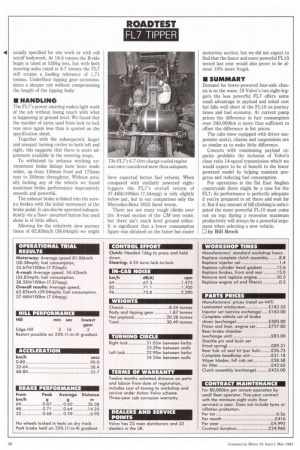ROADTEST FL7 TIPPER
Page 40

If you've noticed an error in this article please click here to report it so we can fix it.
usually specified for site work or with roll on/off bodywork. At 18.8 tonnes the B-ride bogie is rated at 520kg less, but with both steering axles rated at 6.7 tonnes the FL7 still retains a loading tolerance of 1.71 tonnes. Underfloor tipping gear accommodates a sleeper cab without compromising the length of the tipping body.
The FL7's power steering makes light work of the job without losing touch with what is happening at ground level. We found that the number of turns used from lock to lock was once again less than is quoted on the specification sheet.
Together with the subsequently larger and unequal turning circles to both left and right, this suggests that there is more adjustment available in the steering stops.
To withstand its arduous working environment brake linings have been made wider, up from 150mm front and 175mm rear to 200mm throughout. Without actually locking any of the wheels we found maximum brake performance impressively smooth and powerful.
The exhaust brake is linked into the service brakes with the initial movement of the brake pedal. It can also be operated independently via a floormounted button but used alone is of little effect.
Allowing for the relatively slow journey times of 62.82km/h (39.04mph) we might have expected better fuel returns. When compared with similarly powered eightleggers the FL7's overall return of 37.461it/100km (7.54mpg) is only slightly below par, but in our comparison only the Mercedes-Benz 3025 fared worse.
There are not many tough climbs over the A-road section of the CM test route, but there isn't much level ground either. It is significant that a lower consumption figure was obtained on the faster but easier
motorway section, but we did not expect to find that the faster and more powerful FL IO tested last year would also prove to be almost 10% more frugal.
Demand for lower-powered four-axle chassis is on the wane. Of Volvo's two eight-leggers the less powerful FL7 offers some small advantage in payload and initial cost but falls well short of the FLIO on journey times and fuel economy. At current pump prices the difference in fuel consumption over 240,000km is more than sufficient to offset the difference in list prices.
The cabs (now equipped with driver suspension seats), chassis and suspensions are so similar as to make little difference.
Concern with maximising payload capacity prohibits the inclusion of Volvo's close ratio 14-speed transmission which we would expect to be of benefit to the lower powered model by helping maintain progress and reducing fuel consumption.
For operations in the flat East Anglian countryside there might be a case for the FL7: its performance is perfectly adequate if you're prepared to sit there and wait for it. But if any amount of hill climbing is anticipated the more powerful FL10 must come out on top; during a recession maximum productivity will always be a powerful argument when selecting a new vehicle.
by Bill Brock
























































































































